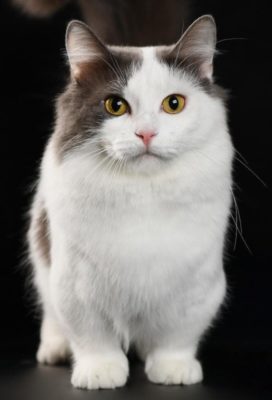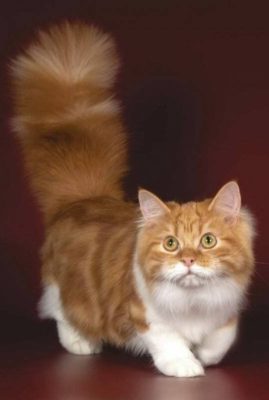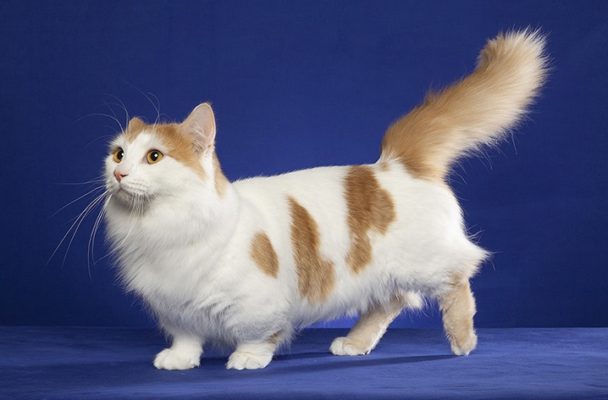Munchkin Longhair
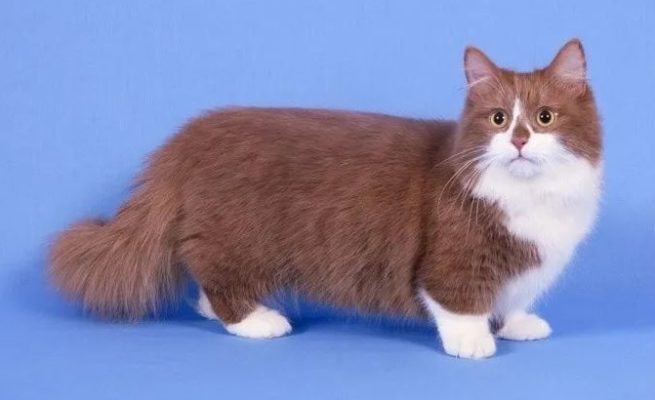
The Munchkin Longhair is a playful, friendly, and intelligent cat. She is strongly attached to her family, loves her owner, and demands a lot of attention from him. The pet adores children and enjoys spending time with them. The cat also gets along well with other animals. Aggression is not peculiar to her; she shows interest in guests.
Table of Contents
Breed Information
| Origin | United States |
| Size | 14-16 cm |
| Weight | Males 3-5 kg Females 2-4 kg |
| Fur Type | Semi-long-haired |
| Color | Anyone |
| Lifestyle | Indoors |
| Lifespan | 12-14 years |
| FIFe Classification | – |
| WCF Classification | Group 2: “Semi-long-haired” Breed designation – MNL |
| TICA Classification | ML |
| Group | Long-haired cats, cats for kids, rare cats |
| Price | $600-2000 |
Breed Photos
Origin History
The breed appeared quite by accident in the 1980s in the United States. In 1983, Sandra Hochschedel from Rayville, Louisiana, found a strange kitten in the street. She mistook the cat’s short limbs for an abnormality, but it later had offspring with the same paws. It meant the presence of a dominant gene due to a mutation. Sandra gave one of the kittens to a farmer named Cai Lafrance. He began breeding the cat, and a couple of years later, a separate breed called the Munchkin was born.
In 1991, the interesting cats were first shown at a show in New York’s Madison Square Garden. The breed became a real success; it was dubbed the “dachshund cat” because of its special short limbs. And the cat got its name after the tiny Munchkin people from Baum’s book The Wizard of Oz. The first organization to recognize the animal was the International Cat Association. It happened in 1995.
Appearance
The distinctive feature of Munchkins is their limbs. They are two to three times shorter than other cats. The pet’s body is elongated, with the back sloping from the shoulders to the tail. The chest is rounded, and the hips are firm. Cats are larger than cats. The tail corresponds to the body’s length, is not thick, and tapers to the tip. The coat is smooth and silky, with a medium undercoat.
The Munchkin’s neck is dense and muscular, with cats slightly larger than cats. The head is wedge-shaped, proportional to the body. The forehead is flat, the transition to the nose is smooth. The muzzle is medium length with prominent cheekbones. Large almond-shaped cat eyes set wide. The ears stand high, the tips rounded.
Character
The Munchkin Longhair is a playful, friendly, and intelligent cat. She is strongly attached to her family, loves her owner, and demands a lot of attention from him. The pet adores children and enjoys spending time with them.
The cat also gets along well with other animals. Aggression is not peculiar to her; she shows interest in guests. A peaceful and sensitive pet loves to be in the company of people. The Munchkin also perfectly adapts to new conditions and tolerates moves well.
Care
This breed’s cat is not adapted to life outside; because of the short legs, the pet cannot climb trees or catch mice. It is a typical pet, which, however, does not mind playing. After a long playtime, the cat needs a rest. Equip it with a special house for this purpose.
A Munchkin’s Longhair requires combining several times a week. Bathe your pet once every two to four months. Every week, trim its claws and buy a scratching post. Do not forget to monitor the condition of the cat’s ears and eyes and remove dirt in time. Provide the Munchkin with a litter box with high sides, so he can freely bury his waste.
Education
Munchkins are highly intelligent and shrewd. They are pretty easily accustomed to the litter box and harness. Training a cat is also easy. Say a command clearly and calmly. Reward your pet with a yummy treat for doing it correctly. They are categorically forbidden to shout and show force to the Munchkin Longhair. So the cat will lose your trust and become withdrawn. Develop your cat with the help of various games, so he will not be bored and will not lose interest in learning.
Common Diseases
In general, the Munchkin Longhair has good health. Closely monitor the diet of the pet; in no case do not overfeed him. So you will avoid many diseases. Typical diseases of the Munchkin Longhair include:
- hypochondroplasia;
- hyperthyroidism;
- pancreatitis;
- lordosis;
- uremia;
- lymphosarcoma.
Don’t forget to show your cat to the vet and get vaccinations. With proper care, Munchkins will live long enough.
Nutrition
Munchkin Longhair nutrition requires special attention. Both ready-made dry premium food and natural food are suitable. Protein products should form the basis of the diet. By-products and lean meat such as rabbit, chicken, beef, and turkey are suitable.
If you overfeed your pet with meat products, he may get protein poisoning. Therefore, you should dilute the diet with cereal, boiled vegetables, and fermented dairy products. Once a week, give the cat boiled saltwater fish and egg yolk. It is contraindicated to feed the Munchkin spicy, smoked, sweet, fatty, and fried foods.
 Kanaani
Kanaani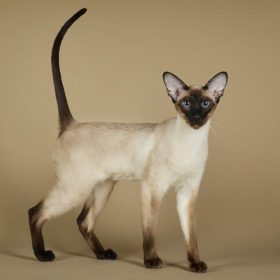 Siamese
Siamese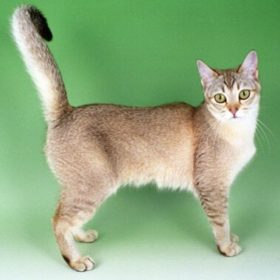 Burmilla Shorthair
Burmilla Shorthair Somali
Somali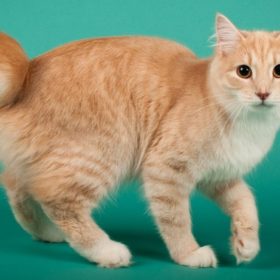 Karelian Bobtail Shorthair
Karelian Bobtail Shorthair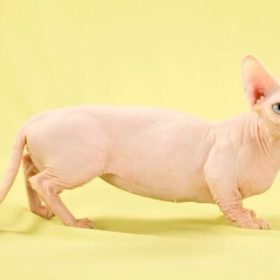 Minskin
Minskin